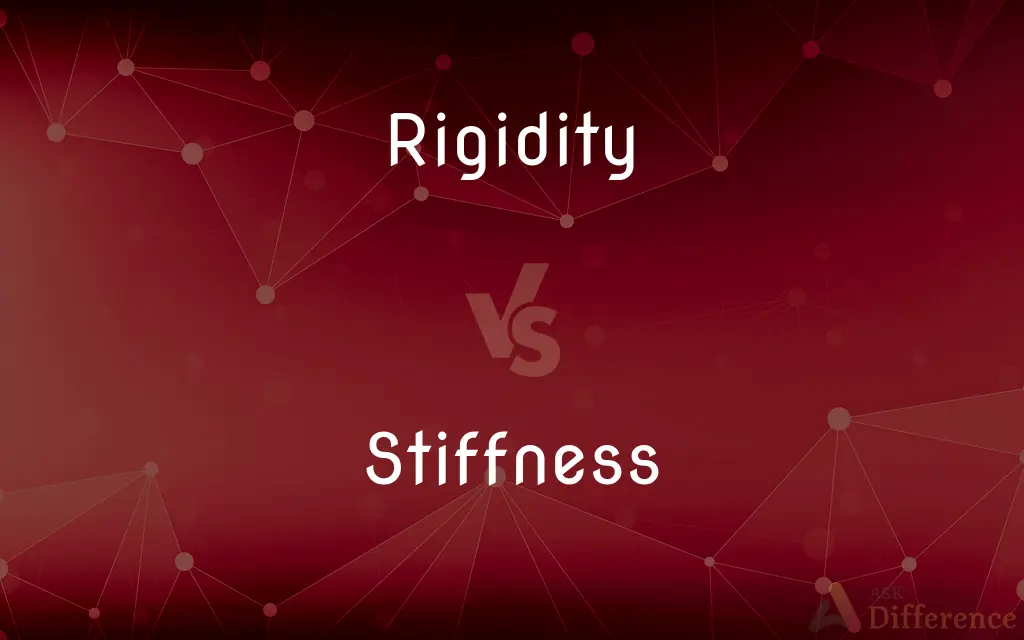Rigidity vs. Stiffness — What's the Difference?
By Tayyaba Rehman & Fiza Rafique — Updated on March 11, 2024
Rigidity refers to an object's resistance to deformation under load, maintaining shape regardless of external forces, while stiffness denotes the degree to an object resists deformation in response to an applied force, measured by the force per unit.

Difference Between Rigidity and Stiffness
Table of Contents
ADVERTISEMENT
Key Differences
Rigidity is a qualitative measure that describes an object's ability to remain undeformed under stress. It implies an absolute resistance to changes in shape or structure, suggesting that the object will not bend, twist, or change form when subjected to external forces. This characteristic is essential in materials and structures where maintaining a constant shape is critical, regardless of the conditions they face. On the other hand, stiffness is a quantitative measure, typically expressed as a ratio of applied force to the resultant deformation (such as in Newtons per meter in the SI system), indicating how much force is required to alter an object's shape by a certain amount.
The distinction between rigidity and stiffness lies in their application and measurement. Rigidity is more about a material's general characteristic of resisting deformation, without specifying how much force it can withstand before deforming. Stiffness, however, provides a specific value that quantifies resistance to deformation, allowing for a more precise comparison between materials or structures under similar conditions. For example, a steel beam might be both rigid and stiff, maintaining its shape under heavy loads and requiring a significant force to deform.
In the context of engineering and physics, understanding the difference between these terms is crucial for material selection and design purposes. Materials with high rigidity and stiffness are chosen for applications where structural integrity and minimal deformation are vital, such as in bridges, skyscrapers, and aerospace engineering. Conversely, applications requiring some degree of flexibility, such as shock absorbers and certain sporting goods, might prefer materials with lower stiffness values to absorb energy and mitigate impacts effectively.
Both rigidity and stiffness are influenced by an object's material properties and geometry. For instance, the shape and size of a structural element can affect its overall stiffness and rigidity. A long, thin rod may have low stiffness (easily deformed by bending) but can still be considered rigid if it resists other forms of deformation, like stretching or compression.
While rigidity and stiffness are related concepts in materials science and engineering, their practical implications and measurements differ significantly. Rigidity conveys a general resistance to deformation, while stiffness provides a precise metric for understanding and predicting how materials will respond to applied forces, crucial for designing safe, efficient, and functional structures and devices.
ADVERTISEMENT
Comparison Chart
Definition
Resistance to deformation under load, maintaining shape
Degree of resistance to deformation per unit force
Measurement
Qualitative
Quantitative (e.g., N/m)
Application
Describes a material's or structure's ability to maintain shape
Used to quantify and compare material responses to force
Context
General characteristic of materials
Specific value important for engineering and design
Influence Factors
Material properties, structure
Material properties, structure, size, and shape
Importance
Essential for applications requiring shape integrity
Crucial for designing with precise deformation responses
Compare with Definitions
Rigidity
The characteristic of being stiff and resistant to bending.
The rigidity of steel beams is crucial for skyscraper construction.
Stiffness
Indicative of the force required to produce a unit deformation.
A material's stiffness is a key factor in designing flexible electronics.
Rigidity
Resistance to change under external forces, maintaining integrity.
The ancient pyramid has endured centuries due to the rigidity of its construction.
Stiffness
The measure of an object's resistance to deformation in response to an applied force.
The stiffness of a spring determines how it compresses under weight.
Rigidity
A property of materials that do not deform easily.
The rigidity of tempered glass contributes to its safety features in automotive applications.
Stiffness
A critical factor in material selection for engineering applications.
The stiffness of composite materials makes them ideal for aerospace structures.
Rigidity
Inflexibility in terms of physical structure or design.
The bridge's rigidity prevents it from swaying under the weight of heavy traffic.
Stiffness
A quantitative attribute that defines how much a material deforms.
Engineers calculate the stiffness of materials to ensure bridges can withstand varying loads.
Rigidity
The quality of being unable to be bent or forced out of shape.
The rigidity of the diamond structure makes it one of the hardest materials known.
Stiffness
The property affecting how a structure responds to stress.
The stiffness of car suspension components affects ride quality and handling.
Rigidity
Inability to be to bent or be forced out of shape
The tough substance that gives plants their rigidity
Stiffness
Stiffness is the extent to which an object resists deformation in response to an applied force.The complementary concept is flexibility or pliability: the more flexible an object is, the less stiff it is.
Rigidity
Inability to be changed or adapted
The rigidity of the school system
Stiffness
Inability to move easily and without pain
Stretching exercises ease stiffness in the legs
Headache and neck stiffness
Rigidity
The quality or state of being rigid.
Stiffness
The quality of being severe or strong
No mean feat given the stiffness of the competition
Rigidity
An instance of being rigid.
Stiffness
Difficult to bend or fold
Stiff new shoes.
A stiff collar.
Rigidity
The quality or state of being rigid; lack of pliability; the quality of resisting change of physical shape
Stiffness
Not moving or operating easily or freely; resistant
A stiff hinge.
Rigidity
The amount of resistance with which a body opposes change of form.
Stiffness
Lacking ease or comfort of movement; not limber
A stiff neck.
Rigidity
Stiffness of appearance or manner; want of ease or elegance.
Stiffness
Not liquid, loose, or fluid; thick
Stiff dough.
Rigidity
(economics) stickiness (of prices/wages etc.). Describing the tendency of prices and money wages to adjust to changes in the economy with a certain delay.
Stiffness
Reserved in manner or strict in observing decorum
A stiff commanding officer.
Rigidity
The quality or state of being rigid; want of pliability; the quality of resisting change of form; the amount of resistance with which a body opposes change of form; - opposed to flexibility, ductility, malleability, and softness.
Stiffness
Lacking grace or easy charm; very formal
A stiff writing style.
Rigidity
Stiffness of appearance or manner; want of ease or elegance.
Stiffness
Firm, as in purpose; resolute
Stiff in their opposition.
Rigidity
Severity; rigor.
Stiffness
Having a strong, swift, steady force or movement
A stiff current.
A stiff breeze.
Rigidity
The physical property of being stiff and resisting bending
Stiffness
Potent or strong
A stiff drink.
Rigidity
The quality of being rigid and rigorously severe
Stiffness
Difficult to deal with, do, or meet
Stiff requirements for admission.
A stiff examination.
Stiffness
Harsh or severe
A stiff penalty.
Stiffness
Excessively high or onerous
A stiff price.
Stiffness
(Nautical) Not heeling over much in spite of great wind or the press of the sail.
Stiffness
In a stiff manner
Frozen stiff.
Stiffness
To a complete extent; totally
Bored stiff.
Stiffness
A corpse.
Stiffness
A person regarded as constrained, priggish, or overly formal.
Stiffness
A drunk.
Stiffness
A person
A lucky stiff.
Just an ordinary working stiff.
Stiffness
A hobo; a tramp.
Stiffness
A person who tips poorly.
Stiffness
To tip (someone) inadequately or not at all, as for a service rendered
Paid the dinner check but stiffed the waiter.
Stiffness
To cheat (someone) of something owed
My roommate stiffed me out of last month's rent.
Stiffness
To fail to give or supply (something expected or promised).
Stiffness
Rigidity or a measure of rigidity.
Stiffness
Inflexibility or a measure of inflexibility.
Stiffness
Inelegance; a lack of relaxedness.
His stiffness hampered the conversation.
Stiffness
Muscular tension due to unaccustomed or excessive exercise or work; soreness.
Stiffness
The quality or state of being stiff; as, the stiffness of cloth or of paste; stiffness of manner; stiffness of character.
The vices of old age have the stiffness of it too.
Stiffness
The physical property of being inflexible and hard to bend
Stiffness
The property of moving with pain or difficulty;
He awoke with a painful stiffness in his neck
Stiffness
The inelegance of someone stiff and unrelaxed (as by embarrassment)
Stiffness
Excessive sternness;
Severity of character
The harshness of his punishment was inhuman
The rigors of boot camp
Common Curiosities
Can a material be rigid but not stiff?
Typically, rigidity and stiffness are related; a material that is considered rigid usually also has high stiffness. However, rigidity is more about the qualitative aspect of resisting deformation, while stiffness is a specific measure. In practice, these terms are often used to complement each other rather than being mutually exclusive.
Can the rigidity of a structure be altered?
Yes, the rigidity of a structure can be altered by changing the material properties, adjusting the geometry, or modifying the design to better resist deformation under load.
How is stiffness measured?
Stiffness is measured by the ratio of the force applied to a material or structure to the resultant deformation, typically in units of force per length (e.g., Newtons per meter).
How do environmental factors affect rigidity and stiffness?
Environmental factors like temperature, humidity, and exposure to chemicals can affect the material properties, potentially reducing rigidity and stiffness over time or under certain conditions.
Why is stiffness important in engineering?
Stiffness is crucial in engineering for designing structures and materials that can withstand specific forces without undergoing unacceptable levels of deformation, ensuring safety, functionality, and durability.
Are there materials that are ideal for applications requiring both high rigidity and stiffness?
Yes, materials like steel, titanium, and certain composites are valued for their high rigidity and stiffness, making them ideal for applications requiring strong resistance to deformation, such as in aerospace and construction.
What determines the stiffness of a material?
The stiffness of a material is determined by its elastic modulus, geometry, and the specific conditions under which it is being measured or used.
What role does geometry play in stiffness and rigidity?
Geometry significantly influences both stiffness and rigidity; for example, increasing the moment of inertia of a beam's cross-section can enhance its stiffness and rigidity against bending.
How do engineers use the concepts of rigidity and stiffness in design?
Engineers use these concepts to select appropriate materials and design structures that meet specific performance criteria, balancing the need for resistance to deformation with the requirements of the application.
Is it possible to increase the stiffness of a material without making it more brittle?
Yes, through material engineering and the development of composite materials, it's possible to enhance stiffness while maintaining or even improving toughness, avoiding increased brittleness.
Share Your Discovery

Previous Comparison
See vs. Seeing
Next Comparison
Apostle vs. EvangelistAuthor Spotlight
Written by
Tayyaba RehmanTayyaba Rehman is a distinguished writer, currently serving as a primary contributor to askdifference.com. As a researcher in semantics and etymology, Tayyaba's passion for the complexity of languages and their distinctions has found a perfect home on the platform. Tayyaba delves into the intricacies of language, distinguishing between commonly confused words and phrases, thereby providing clarity for readers worldwide.
Co-written by
Fiza RafiqueFiza Rafique is a skilled content writer at AskDifference.com, where she meticulously refines and enhances written pieces. Drawing from her vast editorial expertise, Fiza ensures clarity, accuracy, and precision in every article. Passionate about language, she continually seeks to elevate the quality of content for readers worldwide.














































